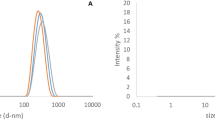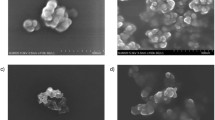Abstract
Essential oils are promising candidates for the substitution of synthetic pesticides owing to their pesticidal and pest repellent features and also lower environmental side effects. Despite the pesticidal effects, the most of essential oils lose their effects against environmental conditions. Nanoformulation is a technique that may protect or improve the pesticidal efficiency of plant essential oils. The acaricidal effect of chitosan nanocapsules loaded with Achillea millefolium L. essential oil against adult Tetranychus urticae Koch is described. The loaded nanoparticles have spherical shape and average diameters between 85 and 145 nm depending on the pH used in the synthesis. During 24-h exposure, the LC50 values of fumigant toxicity for free EO and CS-TPP/EO fabricated at pH = 3.5, 4.5, and 5.5 were obtained 5.05, 18.90, 60.28, and 127.4 µL/L air, respectively. Additionally, by studying contact toxicity the LC50 values after 48-h exposure of T. urticae were determined to be 5.51, 4.23, 3.30, and 1.56 µL/cm2 for free EO and nanoparticles prepared at pH = 3.5, 4.5, and 5.5, respectively. Fumigant and contact lethality tests reveal the slow and persistent release of the Achillea millefolium L. essential oil, proving the effectiveness of chitosan nanoencapsulation in prolonging the acaricidal effect. The lethality performance is shown to be affected by the size of loaded chitosan nanoparticles. Overall, the results showed that nanoformulation of this essential oil saved its pesticidal property for longer time; thus, the technique may be used for improving essential oils efficiency in pest control.



Similar content being viewed by others
References
Ajun W, Yan S, Li G, Huili L (2009) Preparation of aspirin and probucol in combination loaded chitosan nanoparticles and in vitro release study. Carbohyd Polym 75(4):566–574. doi:10.1016/j.carbpol.2008.08.019
Attia S, Grissa KL, Lognay G, Bitume E, Hance T, Mailleux AC (2013) A review of the major biological approaches to control the worldwide pest Tetranychus urticae (Acari: Tetranychidae) with special reference to natural pesticides. J Pest Sci 86(3):361–386. doi:10.1007/s10340-013-0503-0
Benelli G, Pavela R, Canale A, Nicoletti M, Petrelli R, Cappellacci L, Galassi R, Maggi F (2017) Isofuranodiene and germacrone from Smyrnium olusatrum essential oil as acaricides and oviposition inhibitors against Tetranychus urticae: impact of chemical stabilization of isofuranodiene by interaction with silver triflate. J Pest Sci 90(2):693–699. doi:10.1007/s10340-016-0829-5
Calmasur O, Aslan I, Sahin F (2006) Insecticidal and acaricidal effect of three Lamiaceae plant essential oils against Tetranychus urticae Koch and Bemisia tabaci Genn. Ind. Crop Prod 23:140–146. doi:10.1016/j.indcrop.2005.05.003
Camara CAG, Akhtar Y, Isman MB, Seffrin RC, Born F (2015) Repellent activity of essential oils from two species of Citrus against Tetranychus urticae in the laboratory and greenhouse. Crop Prot 74:110–115. doi:10.1016/j.cropro.2015.04.014
Candan F, Unlu M, Tepe B, Deferera D, Polissiou M, Sokmen A, Akpulat HA (2003) Antioxidant and antimicrobial activity of the essential oil and methanol extracts of Achillea millefolium subsp. millefolium Afan. (Asteraceae). J Ethnopharmacol 87(2–3):215–220. doi:10.1016/S0378-8741(03)00149-1
Cavalcanti AN, Baggio CH, Freitas CS, Rieck L, Sousa RSD, Silva-Santos JED, Mesia-Vela S, Marques MCA (2006) Safety and antiulcer efficacy studies of Achillea millefolium L. after chronic treatment in Wistar rats. J Ethnopharmacol 107:277–284. doi:10.1016/j.jep.2006.03.011
Cavalcanti SCH, Niculau EDS, Blank AF, Camara CAG, Araujo IN, Alves PB (2010) Composition and acaricidal activity of Lippia sidoides essential oil against two-spotted spider mite (Tetranychus urticae Koch). Bioresource Technol 101:829–832. doi:10.1016/j.biortech.2009.08.053
De Campos AM, Sanchez A, Alonso MAJ (2001) Chitosan nanoparticles: a new vehicle for the improvement of the delivery of drugs to the ocular surface. Application to cyclosporin A. Int J Pharmaceut 224(1):159–168. doi:10.1016/S0378-5173(01)00760-8
Dutta PK, Dutta J, Tripathi VS (2004) Chitin and chitosan: chemistry, properties and applications. J Sci Ind Res India 63:20–31. doi:10.1016/j.progpolymsci.2006.06.001
Finney DJ (1971) Probit Analysis, 3rd edn. Cambridge University Press, New York, p 350
Ghormade V, Desphande MV, Paknikar KM (2011) Perspectives for nanobiotechnology enabled protection and nutrition of plants. Biotech Adv 29:792–803. doi:10.1016/j.biotechadv.2011.06.007
Gonzalez JO, Gutierrez MM, Ferrero AA, Band BF (2014) Essential oils nanoformulations for stored-product pest control–Characterization and biological properties. Chemosphere 100:130–138. doi:10.1016/j.Chemosphere.2013.11.056
Hammer KA, Carson JF, Riley TV (1999) Antimicrobial activity of essential oils and other plant extracts. J Appl Microbiol 86:985–990. doi:10.1046/j.1365-2672.1999.00780.x
Hu X, Wang Y, Peng B (2014) Chitosan-capped mesoporous silica nanoparticles as pH-responsive nanocarriers for controlled drug release. J Chem-Asian 9:319–327. doi:10.1002/asia.201301105
Huang Y, Cai Y, Lapitsky Y (2015) Factors affecting the stability of chitosan/tripolyphosphate micro-and nanogels: resolving the opposing findings. J Mater Chem B 3(29):5957–5970. doi:10.1039/C5TB00431D
Institute SAS (1999) SAS/STAT Software: Changes and enhancements though release 8. SAS. SAS institute inc., Cary
Keawchaoon L, Yoksan R (2011) Preparation, characterization and in vitro release study of carvacrol-loaded chitosan nanoparticles. Colloid Surface B 84(1):163–171. doi:10.1016/j.colsurfb.2010.12.031
Kouchak M, Azarpanah A (2015) Preparation and in vitro evaluation of chitosan nanoparticles containing diclofenac using the ion-gelation method. Jundishapur Nat Pharm Product 10(2):1–7. doi:10.17795/jjnpp-23082
Lai F, Wissing SA, Müller RH, Fadda AM (2006) Artemisia arborescens L. essential oil–loaded solid lipid nanoparticles for potential agricultural application: preparation and characterization. AAPS Pharm Sci Tech 7:1–9. doi:10.1208/pt070102
Lee E, Park SJ, Lee JH, Kim MS, Kim CH (2015) P-049 –Preparation of chitosan TPP nanoparticles and their physical and biological properties. Asian J Pharm Sci 11(1):166–167. doi:10.1016/j.ajps.2015.11.065
Migeon A, Dorkeld F (2006–2016) Spider Mites Web: a comprehensive database for the Tetranychidae. http://www.montpellier.inra.fr/CBGP/spmweb
Mockute D, Judzentiene A (2003) Variability of the essential oils composition of Achillea millefolium Millefolium growing wild in Lithuania. Biochem Syst Ecol 31:1–13. doi:10.1016/S0305-1978(03)00066-8
Murungi LK, Kirwa H, Torto B (2013) Differences in essential oil content of berries and leaves of Solanum sarra choides (Solanaceae) and the effects on oviposition of the tomato spider mite (Tetranychus evansi). Ind Crop Prod 46:73–79. doi:10.1016/j.indcrop.2013.01.022
Nasti A, Zaki NM, de Leonardis P, Ungphaiboon S, Sansongsak P, Rimoli MG, Tirelli N (2009) Chitosan/TPP and chitosan/TPP-hyaluronic acid nanoparticles: systematic optimization of the preparative process and preliminary biological evaluation. Pharm Res-Dordr 26(8):1918–1930. doi:10.1007/s11095-009-9908-0
Natrajan D, Srinivasan S, Sundar K, Ravindran A (2015) Formulation of essential oil-loaded chitosanealginate nanocapsules. J Food Drug Anal 23:560–568. doi:10.1016/j.jfda.2015.01.001
Nenaah GE (2014) Chemical composition, toxicity and growth inhibitory activities of essential oils of three Achillea species and their nano-emulsions against Tribolium castaneum (Herbst). Ind Crop Prod 53:252–260. doi:10.1016/j.indcrop.2013.12.042
Oliveira EF, Paula HCB, Paula RCM (2014) Alginate/cashew gum nanoparticles for essential oil encapsulation. Colloid Surface B 113:146–151
Orav A, Arak E, Raal A (2006) Phytochemical analysis of the essential oil of Achillea millefolium L. from various European Countries. J Asian Ant Prod Res 12:1082–1088. doi:10.1080/14786410500510849
Paduch R, Matysik G, Nowak-Kryska M, Niedziela P, Kandefer-Szerszen M (2008) Essential oil composition and in vitro biological activity of Achillea millefolium L. extracts. J Pre-Clinical Clinical Res 2(1):049–058
Pavela R (2017) Extract from the roots of Saponaria officinalis as a potential acaricide against Tetranychus urticae. J Pest Sci 90(2):683–692. doi:10.1007/s10340-016-0828-6
Radušiene J, Gudaityte O (2005) Distribution of proazulenes in Achillea millefolium s.l. wild populations in relation to phytosociological dependence and morphological characters. Plant Genet Resour-C 3:136–143. doi:10.1079/PGR200568
Tarelli G, Zerba EN, Alzogaray A (2009) Toxicity to vapor exposure and topical application of essential oils and monoterpenes on Musca domestica (Diptera: Muscidae). J Econ Entomolo 102:1383–1388. doi:10.1603/029.102.0367
Tyler A, John WS (1988) Acarology: Mites and human welfare. published simultaneously in Canada 484 pp
Ünlü M, Daferera D, Donmez E, Polissiou M, Tepe B, Sokmen A (2002) Compositions and the in vitro antimicrobial activities of the essential oils of Achillea setacea and Achillea teretifolia (Compositae). Ethnopharmacol 83(1–2):117–121. doi:10.1016/S0378-8741(02)00218-0
van Leeuwen T, Vontas J, Tsagkarakou A, Dermauw W, Tirry L (2010) Acaricide resistance mechanisms in the two-spotted spider mite Tetranychus urticae and other important Acari: a review. Insect Biochem Molec 40(8):563–572. doi:10.1016/j.ibmb.2010.05.008
Varona S, Kareth S, Martin A, Cocero M (2010) Formulation of lavandin essential oil with biopolymers by PGSS for application as biocide in ecological agriculture. J Supercrit Fluid 54:369–377. doi:10.1016/j.supflu.2010.05.019
Weinzierl RA (2000) Botanical insecticides, soaps and oils. In: Jack ER (ed) Biological and biotechnological control of insect pests. Lewis Publishers, Boca Raton, pp 101–121
Woranuch S, Yoksan R (2013) Eugenol-loaded chitosan nanoparticles: I. Thermal stability improvement of eugenol through encapsulation. Carbohyd Polym 96(2):578–585. doi:10.1016/j.carbpol.2012.08.117
Zhang Z (2003) Mites of greenhouses: identification, biology and control. CABI Publishing, Wallingford, pp 54–56
Ziaee M, Moharramipour S, Mohsenifar A (2014) MA-chitosan nanogel loaded with Cuminum cyminum essential oil for efficient management of two stored product beetle pests. J Pest Sci 87(4):1–9. doi:10.1007/s10340-014-0590-6
Acknowledgement
We greatly appreciate the support for this project provided by the Research Divisions of University of Maragheh, Iran. This research was funded by Research affairs of University of Maragheh/Iran which is appreciated. This article is part of my Ph.D. Dissertation research, and the co-authors are my supervisor and advisor.
Author information
Authors and Affiliations
Corresponding author
Ethics declarations
Conflict of interest
All co-authors declare that they have no conflict of interest.
Human and animals rights
This article does not contain any studies with human participants or animals performed by any of the authors.
Additional information
Communicated by M. B. Isman.
Rights and permissions
About this article
Cite this article
Ahmadi, Z., Saber, M., Bagheri, M. et al. Achillea millefolium essential oil and chitosan nanocapsules with enhanced activity against Tetranychus urticae . J Pest Sci 91, 837–848 (2018). https://doi.org/10.1007/s10340-017-0912-6
Received:
Revised:
Accepted:
Published:
Issue Date:
DOI: https://doi.org/10.1007/s10340-017-0912-6




